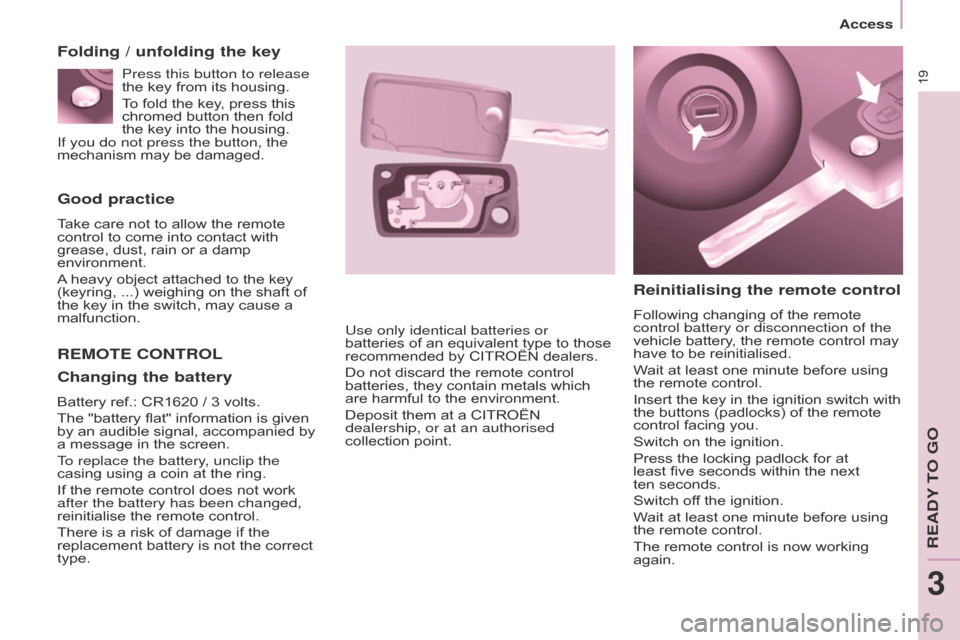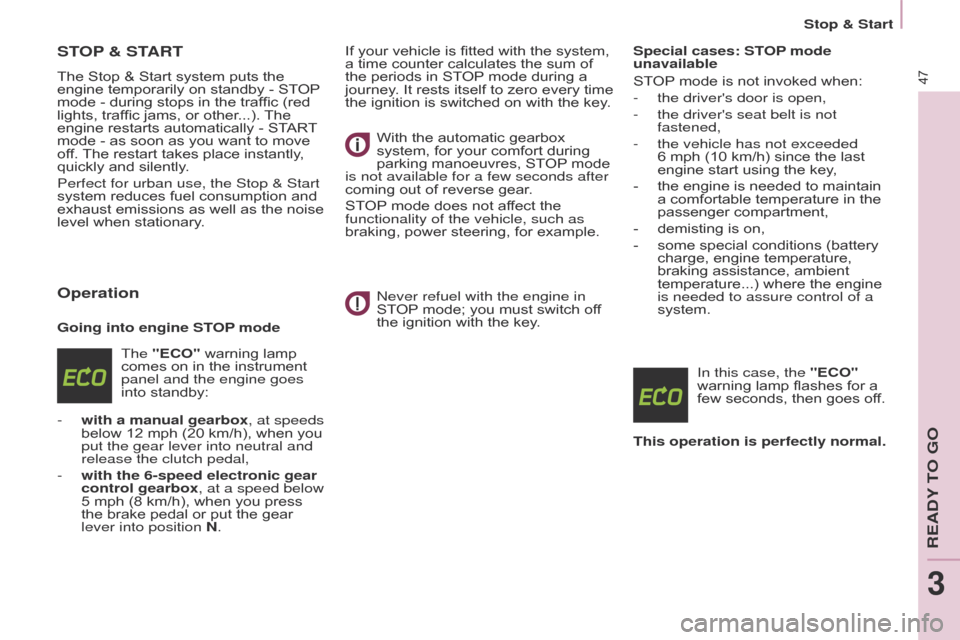key battery Citroen BERLINGO MULTISPACE RHD 2015 2.G Owner's Manual
[x] Cancel search | Manufacturer: CITROEN, Model Year: 2015, Model line: BERLINGO MULTISPACE RHD, Model: Citroen BERLINGO MULTISPACE RHD 2015 2.GPages: 276, PDF Size: 12.21 MB
Page 21 of 276

19
Berlingo_2_VP_en_Chap03_Pret-a-partir_ed02-2014
Good practice
Take care not to allow the remote control to come into contact with
grease,
dust, rain or a damp
environment.
A
heavy object attached to the key
(keyring,
...) weighing on the shaft of
the
key in the switch, may cause a
malfunction.
rEMOtE cOntrOL
r
einitialising the remote control
Following changing of the remote control battery or disconnection of the
vehicle
battery, the remote control may
have
to be reinitialised.
Wait
at least one minute before using
the
remote control.
Insert
the key in the ignition switch with
the
buttons (padlocks) of the remote
control
facing you.
Switch
on the ignition.
Press
the locking padlock for at
least
five seconds within the next
ten seconds.
Switch
off the ignition.
Wait
at least one minute before using
the
remote control.
The
remote control is now working
again.
Use only identical batteries or
batteries
of
an
equivalent
type
to
those
recommended
by
CITROËN
dealers.
Do
not
discard
the
remote
control
batteries,
they
contain
metals
which
are
harmful
to
the
environment.
Deposit
them
at
a
CITROËN
dealership, or at an authorised
collection
point.
Folding / unfolding the key
c
hanging the battery
Battery ref.: CR1620 / 3 volts.
The "battery flat" information is given
by
an audible signal, accompanied by
a
message in the screen.
To replace the battery, unclip the
casing
using a coin at the ring.
If
the remote control does not work
after the battery has been changed,
reinitialise
the remote control.
There
is a risk of damage if the
replacement
battery is not the correct
type.Press this button to release
the
key from its housing.
To fold the key, press this
chromed
button then fold
the
key into the housing.
If you do not press the button, the
mechanism
may be damaged.
access
REadY To Go
3
Page 25 of 276

23
Berlingo_2_VP_en_Chap03_Pret-a-partir_ed02-2014
Operation in the event of a
battery failure
Front and side passenger doors
In the event of a battery or of the
central locking fault, use the lock to
lock
the doors mechanically.
-
T
o open the door and get out of the
vehicle,
pull the interior control.
-
T
o lock the door, insert the key in
the
lock, located on the edge of the
door
, then turn it one eighth of a
turn.
d
river's door
-
Insert
the key in the lock, then turn
it
to the right to lock or to the left to
unlock.
tAILGAtE
From inside
Emergency control
In the event of a central unlocking
operating
fault, this permits unlocking
of
the tailgate from the inside.
Insert
a small screwdriver in the
opening, between the tailgate and the
floor
.
T
o unlock the lock, move the
catch
to the left then push the tailgate.
From outside
Locking/unlocking is by means of the remote control.
To open, press the control below the
trim
then raise the tailgate.
a pull strap is available to close the
tailgate
in the high position.
Guide the closing of the tailgate to the
balance point of its travel then apply
a
final press on the tailgate to close it
fully
.
access
REadY To Go
3
Page 49 of 276

Berlingo_2_VP_en_Chap03_Pret-a-partir_ed02-2014
47
StOP & StArt
The Stop & Start system puts the engine
temporarily on standby - STOP mode
- during stops in the traffic (red
lights,
traffic jams, or other...).
The
engine
restarts automatically - START
mode
- as soon as you want to move
of
f.
The
restart takes place instantly,
quickly
and silently.
Perfect for urban use, the Stop & Start
system
reduces fuel consumption and
exhaust
emissions as well as the noise
level
when stationary.
Operation
Going into engine StOP mode
The "E c O" warning lamp
comes
on in the instrument
panel and the engine goes
into
standby:
-
with a manual gearbox
, at speeds
below
12 mph (20 km/h), when you
put the gear lever into neutral and
release the clutch pedal,
-
with the 6-speed electronic gear
control gearbox
, at a speed below
5
mph (8 km/h), when you press
the
brake pedal or put the gear
lever into position
n .If
your vehicle is fitted with the system,
a
time counter calculates the sum of
the
periods in STOP
mode during a
journey
. It rests itself to zero every time
the
ignition is switched on with the key.
With the automatic gearbox
system,
for your comfort during
parking
manoeuvres, STOP
mode
is not available for a few seconds after
coming
out of reverse gear.
STOP
mode does not affect the
functionality of the vehicle, such as
braking,
power steering, for example.
n
ever refuel with the engine in
STOP
mode; you must switch off the
ignition with the key.Special cases: S t
OP
mode
unavailable
STOP
mode is not invoked when:
-
the driver's door is open,
-
the driver's seat belt is not
fastened,
-
the vehicle has not exceeded
6 mph
(10 km/h) since the last
engine
start using the key,
-
the
engine is needed to maintain
a
comfortable temperature in the
passenger
compartment,
-
demisting
is on,
-
some
special conditions (battery
charge,
engine temperature,
braking
assistance, ambient
temperature...)
where the engine
is needed to assure control of a
system.
In this case, the
"E c O"
warning
lamp flashes for a
few
seconds, then goes off.
t
his operation is perfectly normal.
Stop & Start
REadY To Go
3
Page 51 of 276

Berlingo_2_VP_en_Chap03_Pret-a-partir_ed02-2014
49
reactivation
Press the "EcO OFF" switch again.
The system is active again; this is
confirmed
by the switch warning
lamp
going off and a message in the
instrument
panel.
The
system is reactivated
automatically
at every new start
using
the key.
Operating fault
In the event of a malfunction with the system, the "E c O
OFF"
switch warning lamp
flashes,
then comes on
continuously
.
Maintenance
Before working under the bonnet, deactivate the Stop & Start system
to
avoid any risk of injury resulting
from
automatic operation of START
mode.
This
system requires a specific
battery
with a special specification
and
technology (reference numbers
available
from a CITROËN dealer or a
qualified
workshop).
Fitting a battery not listed by
CITROËN introduces
the risk of
malfunction
of the system.
The
Stop & Start system makes
use
of advanced technology.
All
work
on this type of battery must
be done only by a CITR
o Ë n dealer or
a
qualified workshop.
have
it
checked
by
a
CITROËN
dealer
or
a
qualified
workshop.
In
the
event
of
a
fault
in
STOP
mode,
the
vehicle
may
stall.
All
of
the
warning
lamps
in
the
instrument
panel
come
on.
It
is
then
necessary
to
switch
off
the ignition and start the engine again
using
the
key.
Stop & Start
REadY To Go
3
Page 160 of 276

158
Berlingo_2_VP_en_Chap08_aide-rapide_ed02-2014
EcOnOMY MOdE
after the engine has stopped, with
the key in the ignition position, certain
functions (windscreen wiper
, electric
windows,
courtesy lamps, audio
equipment,
etc.) can only be used for a
cumulative
duration of thirty minutes,
to
prevent discharging of the battery.
Once
the thirty minutes are over, the
active functions are put on standby
and
the battery warning lamp flashes
accompanied
by a message in the
screen.
T
o resume the use of these functions
immediately
, start the engine and let it
run
for a few minutes.
The
time available will then be double
the
time for which the engine was left
running.
However, this time will always
be
between five and thirty minutes.
A
flat battery will prevent the
engine
from starting.
Battery